The Nittany Lion comes to Lancaster: Penn State Health Lancaster Medical Center opens for business
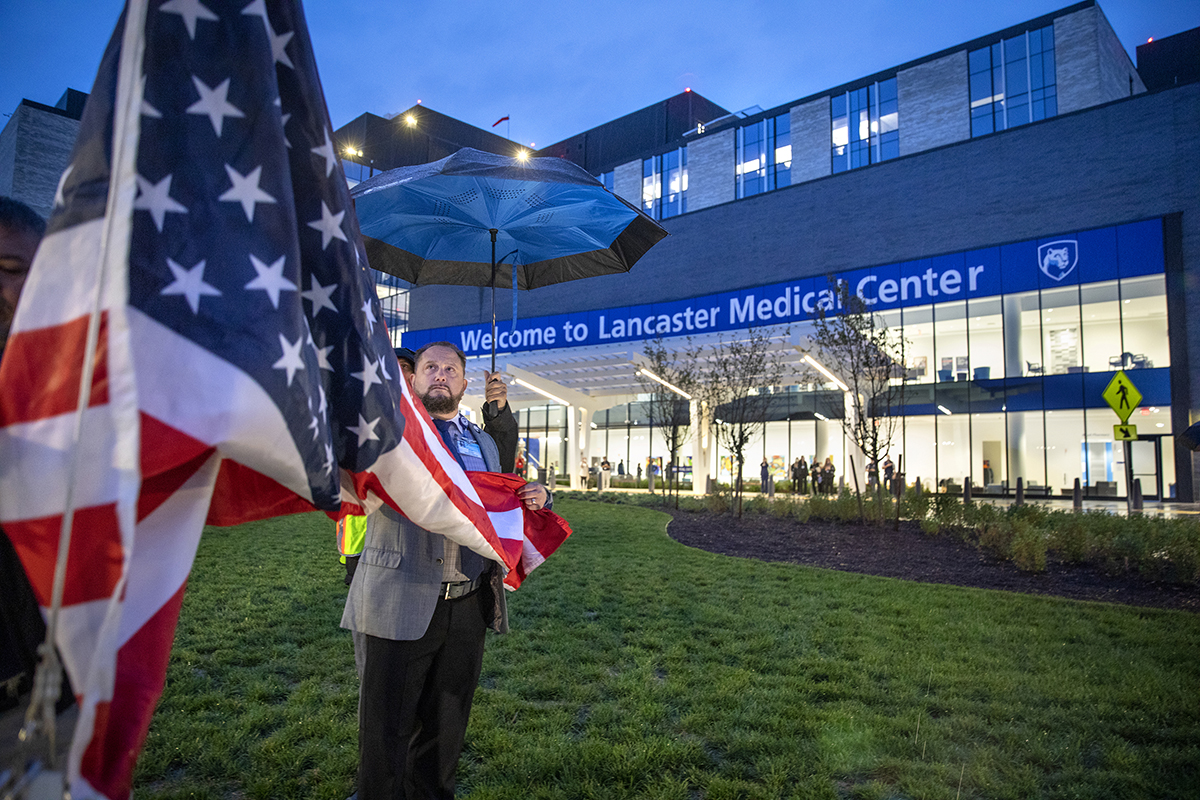
Today at 7 a.m., Penn State Health Lancaster Medical Center, the long-awaited 142-bed acute care hospital, opened its doors and began treating patients. Follow the day’s events below:
5:30 a.m.
In the dark, employees hunch under umbrellas and raincoats against the steady rains brought by the tattered remnants of Hurricane Ian as they make their way toward Day One in the glowing glass, steel and stone hospital.
Inside, monitors in empty operating rooms flash “Ready to Use” messages. Whiteboards offer messages like “Welcome to ICU” with signatures from health care workers who have been preparing for this day for months.
Among them is Eric Burkman, a registered nurse in the Post-Anesthesia Care Unit, who leans over a pacer machine, testing it. The machine can act as an emergency defibrillator and pacemaker.
“I am ready to take care of patients,” he says, grinning underneath his mask. He was among the first wave of employees hired and has been training for this day since July. He spent more than 20 years in health care, but this is his first new hospital. And it’s only three miles from his house.
On the first floor, Kristofer Miller is also getting ready for his first day with people. The operations manager replaces the bags in the silver cans near the cafeteria. For months he’s been clearing construction debris. “I’ve logged something like 70 hours on the little Zamboni,” he says, referring to the floor buffer he’s been riding for weeks.
Like Burkman, he’s worked for years in health care – 17 of them at Penn State Health Milton S. Hershey Medical Center – but he’s never opened a new hospital before.
“I have no idea what to expect,” he says, laughing.
6 a.m.
Dr. Amer Abu-Obeid strides into the hospital and is immediately greeted by a scrum of executives and doctors.
The anesthesiologist arrived in Lancaster the night before and checked into a nearby Comfort Inn. This is his first time in the building where he’ll help set up the Medical Center’s anesthesiology operations. Part of what he and colleagues refer to as a SWAT team, Abu-Obeid drops into hospitals to assist them as they build systems to sedate patients, numb their pain and prepare them for surgery.
“This is the second time I’ve helped open a hospital,” he says. The first was 27 years ago in Jordan. Princess Raiyah of Jordan was in attendance.
Abu-Obeid came to the U.S. in 1996, worked at hospitals like Cleveland Clinic and Allegheny General Hospital for decades. He was recently providing care at Brandywine Hospital in Coatesville.
6:20 a.m.
High-pitched cheers and a flurry of pre-dawn pompoms greet coffee- and umbrella-carrying employees as they report for work on opening day at the new medical center.
A little caffeine mixed with adrenaline are all the fuel Jenifer Michael needs to bounce around the hallway with fellow employee recruiters inside the side entrance, creating a blue-and-white blur of welcome for bleary-eyed employees.
“Six o’clock in the morning and we’re pepped!” she yells.
They brace themselves each time they hear the door click, ready to shower people in scrubs and suits alike with smiles and well-wishes for a great opening day.
“Don’t use up all your energy when no one is coming in!” she yells to fellow recruiters Trevor Smith, Jenniffer Montosa and Kiara Cruz. “Save it!”
Maryandra Walters, vice president and chief application officer, wanders into the hallway with Cletis Earle, Penn State Health senior vice president and chief information officer, and Steve Keller, regional director of information services.
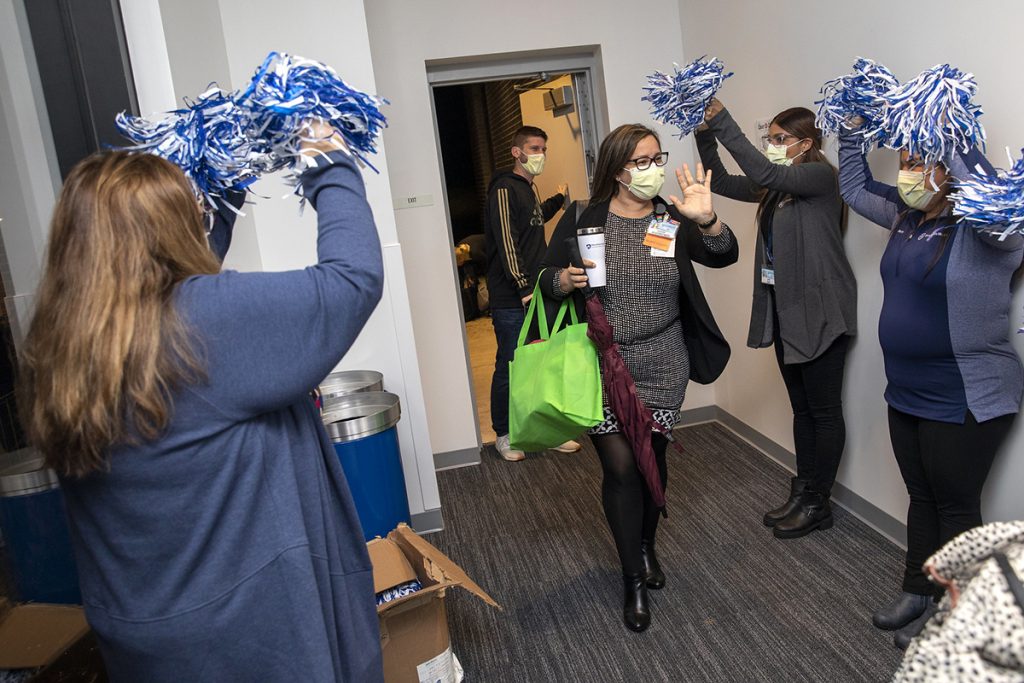
Staff members greet and cheer colleagues as they come in for opening day at Penn State Health Lancaster Medical Center on Monday, Oct. 3, 2022.
Immediately, the recruiters push clumps of blue-and-white plastic strands into their hands.
“Darn, pompoms! I’m in my element!” Walters says, spinning two in her hands. “I had no idea ─ I would have been here at 5.”
Fresh off a TV news interview, nurse leader Kelli Buzzard struts down the hall and grabs a pair of pompoms to join the fun, kicking her legs and pumping her arms.
“This is my normal,” she says, smile lines sneaking out the corners of her mask.
This summer, Buzzard left another health system after 30 years to join Penn State Health at the new Lancaster Medical Center. “It got too big, and I felt like a number,” she said. “Plus, I turned 50 and needed something different.”
6:45 a.m.
Jim Bitler, facilities manager for the new Medical Center, strolls past floor-to-ceiling front windows, down the lighted corridor inside the main entrance with three flag triangles tucked under his arm.
He passes through a cluster of six staff cheering as they greet the earliest-arriving employees and visitors and heads into the rainy, pre-dawn darkness. There, he meets a crowd of employees braving the wet and cold to watch the first flag-raising.
Many are from the radiology department, there to support their director, disabled veteran Bryan Schmalhofer, as he helps raise the United States flag.
“This is how you get sick,” jokes ultrasound tech Hannah Carlson, shivering under a drippy umbrella with MRI tech Sara Weidman. “He’s worth it though,” Weidman replies. Penn State Health has earned national recognition for supporting veterans and their families through its hiring and employment practices.
Bitler hands the Commonwealth of Pennsylvania flag to network engineer and Army veteran Ron Etheridge. He gives the Penn State Health flag to Penn State alum and nurse educator Lisa Ruth-Sahd.
“It’s tradition that the raising of the flag be accompanied by ceremony,” Bitler says. “So we have invited any veterans, active servicemen, firefighters and police officers to join us. It’s an honor to be here and to work with you.”
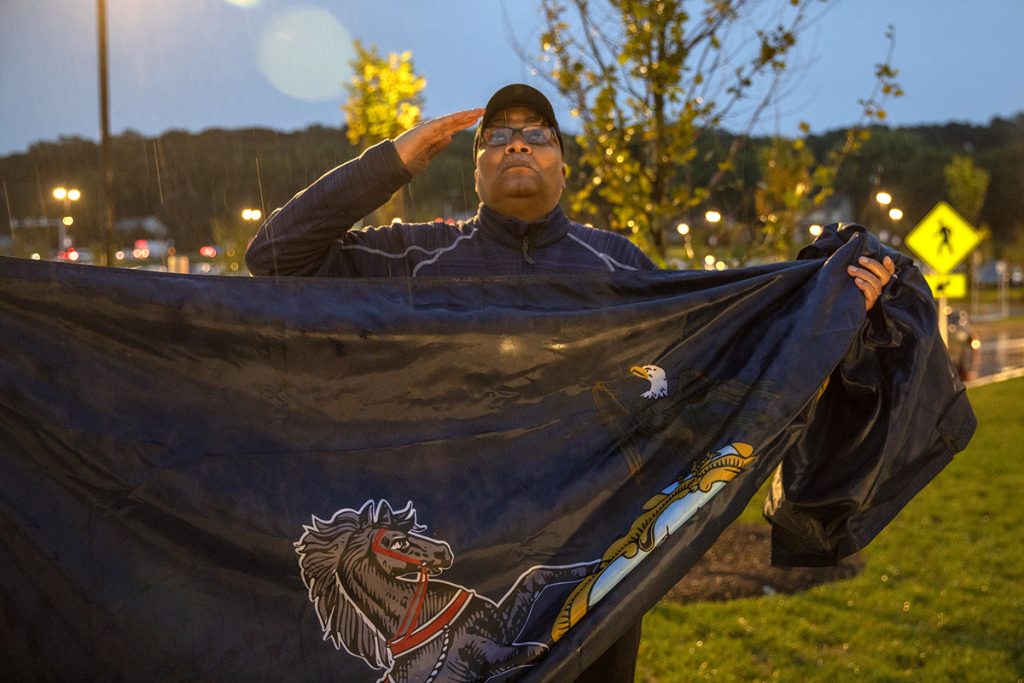
Ron Etheridge Sr. with Information Services at Penn State Health salutes as the American flag is hoisted up the flagpole on opening day at Penn State Health Lancaster Medical Center on Monday, Oct. 3, 2022.
Under the cover of blue and black umbrellas, onlookers scurry from the covered porch to the three flagpoles with white chrysanthemums and pumpkins at their base.
Security officer Mario Moya Jr. leaves his post directing morning traffic to tag behind Bitler, holding an umbrella over him as he secures the cords.
A speaker pulsing red, blue and green lights broadcasts the Star-Spangled Banner.
Etheridge and Schmalhofer stand in salute, as the flags are proudly hoisted up the poles.
“Thank you for your service. This was a great moment,” Bitler says.
Etheridge responds: “This was three years in the making and I’m proud to be here.”
6:59 a.m.
The Medical Center is only just about to open, but pharmacy technician Megan Deaven is already on the move. She wheels a small gray cart down the short hallway between Pharmacy and the Emergency Department, past some elevators — more Day One employees are heading to their stations, hellos and good mornings cheerfully passed around — then through a set of double doors and past the nursing station to the resuscitation bays.
“In one minute, we will be opening our doors to Lancaster County,” says Claire Mooney, senior vice president and chief operating officer of the new Medical Center, via the hospital’s overhead system. “I want to thank everyone for their hard work, dedication — their commitment to resilience, compassion…and the work they’ve done to get this hospital open. I’m so happy and so proud to announce that we are…open! Have a great day.”
For Elizabethtown resident Deaven, today is a great day already. She’s not new to pharmacy work but joined Penn State Health only a few months ago. The excitement of an opportunity to start a new hospital drew her to her role, which at this moment is stocking the ED’s resuscitation area medication station.
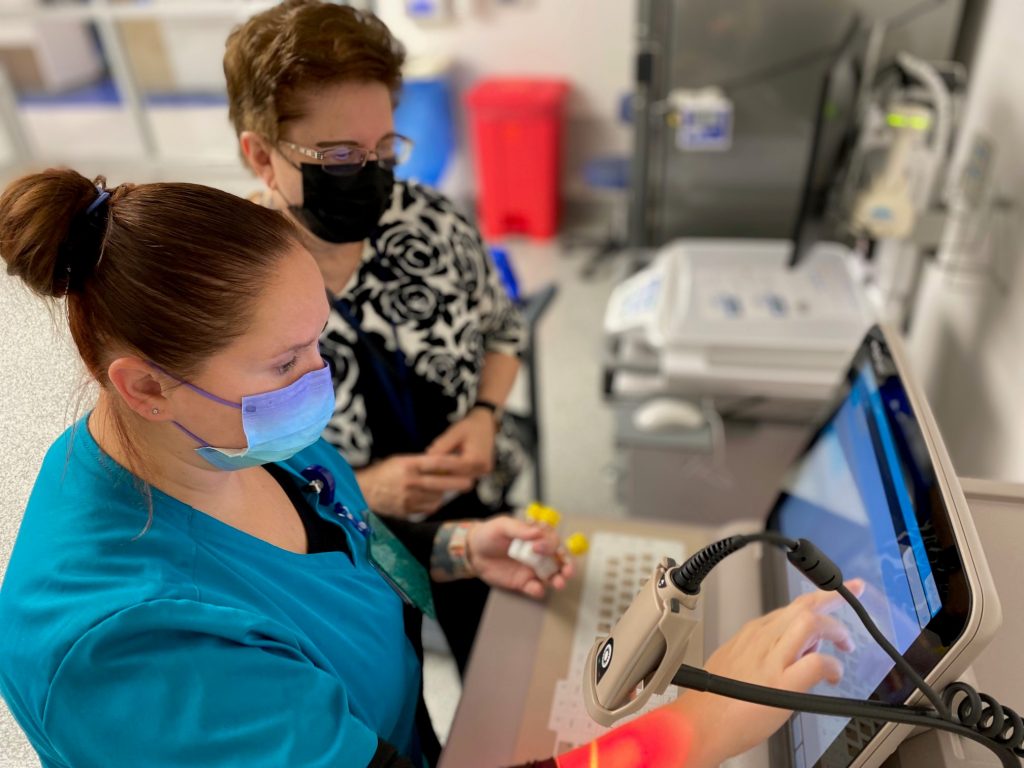
Marian Rhoads, right, regional director of pharmacy, and Megan Deaven, pharmacy technician, stock medications in the resuscitation area of the emergency department at the new Penn State Health Lancaster Medical Center.
For the doctors, nurses and other staff on clinical units of a hospital, Pyxis medication stations are an important part of the arsenal in getting patients the treatments they need, when they need them without extra time or trips to the pharmacy. But here in resuscitation, where seconds can determine a patient’s outcome, Deaven and Marian Rhoads, regional director of pharmacy, are paying special attention to this unassuming tan cart of drawers with a touchscreen brain perched on top. They’re making important stocking adjustments to ensure the ED’s medical teams have just what they need, exactly where they expect it to be when that need eventually comes—whether in today’s first hours or another day.
While they work, another ED huddle led by Dr. Michael Reihart, medical director for emergency medicine, is wrapping up. “We are ready,” Reihart says as the group breaks up.
Back inside the resuscitation area, vials and bags of solution that are literal lifesavers go from three blue plastic bins on Deaven’s care into the med station’s drawers, codes for which Deaven and Rhoads type on to the screen atop. They’re using input from an earlier huddle with ED nurses and doctors to make sure the Pyxis station’s setup and the team’s expectations are a match, to avoid delays and potential medication errors in the heat of the moment.
For Rhoads, today is both a first and an easy comparison to the last new hospital she helped open. In 2006 she helped move St. Joseph Medical Center from downtown Reading to its current Bern Township location. That was a highlight of her nearly 40-year tenure with St. Joseph’s. “That was a huge undertaking, moving to a brand-new building, but at least you had your staff and your supplies,” she says.
Today in Lancaster, the hospital opening is the pay-off to all the hard work the pharmacy team put in over the months leading up to this day—both at this new hospital and at St. Joseph Medical Center—to acclimate to the health system and each other. “This has been a massive project — a new building, new staff, new providers — stocking the pharmacy with all the necessary drugs while navigating all the shortages, trying to anticipate what might be needed in these first few days and weeks…it’s been amazing to see how well the team has gelled. I’m extremely proud and impressed by all the work they’ve done.”
7:03 a.m.
“I volunteer for everything,” says Cheryl Bealer.
The certified wound ostomy continence nurse needs routine bloodwork, and it just so happens she’s working her first shift at Lancaster County’s newest acute care hospital on its first day treating patients.
“I’ll be the first one,” she says.
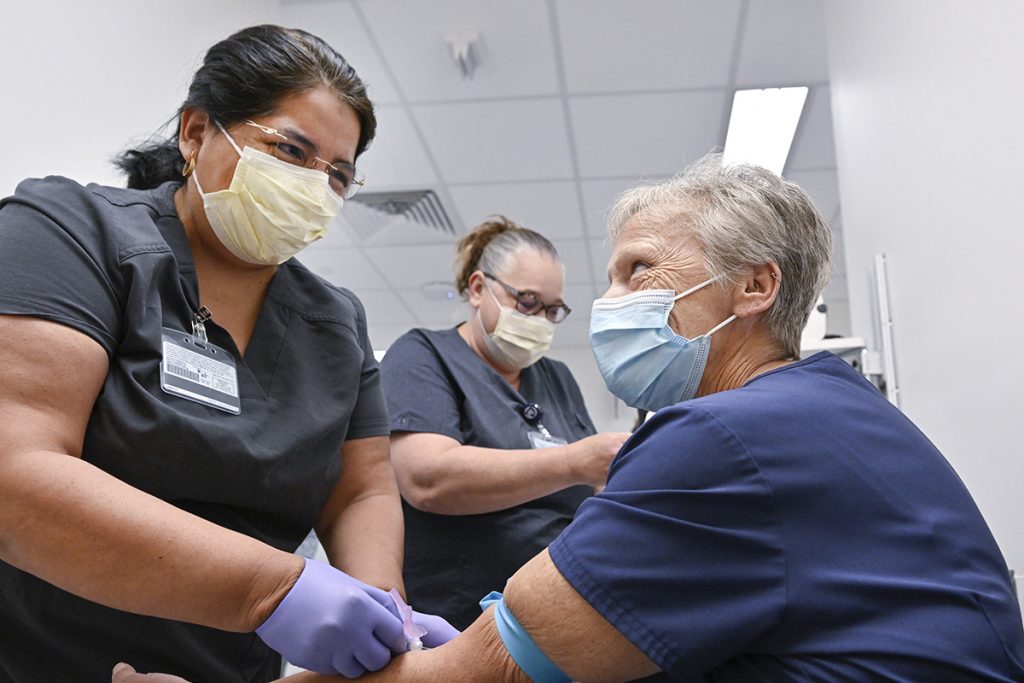
Lab assistant Fatima Carrera draws blood from Cheryl Bealer as fellow lab assistant Erika Morant, back, works at the Penn State Health Lancaster Medical Center Monday Oct. 3, 2022.
Moments after the WE ARE OPEN sign flashes on, Bealer steps into the outpatient laboratory and became a pioneer ― first patient at Lancaster Medical Center to offer up a sample of blood for testing.
The computer’s software takes Bealer’s insurance and personal information. A jar of fake eyeballs ― an early Halloween decoration ― sits on a corner of the desk. Kelly Emmert, a technology educator at Penn State Health St. Joseph Medical Center ― is working at Lancaster Medical Center for the day to help train employees on the new systems, cheers.
“I love it when things work,” Emmert says, pressing her palms together. On one wrist is tattooed the word “serenity.”
Another health care worker takes Bealer back through a door with an “Enter if You Dare” sign (more Halloween tongue-in-cheek). She sits in a chair, rolls up her sleeve and phlebotomist Fatima Carrera does the honors.
“Thanks for being the first patient,” Carrera says.
“It’s all in the family,” Bealer says.
They high-five one another.
8 a.m.
Harold Engle and his wife Nancy walk through the cardiology waiting room and up to the desk to check in for his 8 a.m. appointment.
The 85-year-old is the first patient in the outpatient services building adjacent to the main hospital, and he’s eager to tell anyone who will listen about how the doctors at Penn State Health saved his life.
He had triple bypass surgery in June 2021 at Penn State Health Milton S. Hershey Medical Center and spent about three months in and out of the hospital between complications and a gallbladder attack.
“He had a follow-up bleed after his surgery,” Nancy Engle said. “We had a very alert nurse who called the doctor, and within an hour he was back in surgery. He’s a miracle, and it’s because of Penn State Health that he’s here today.”
The couple live in Elizabethtown but are in the process of moving to a new house three miles from the new Lancaster Medical Center. “It’s nice to have something closer to home,” Nancy says. “We’ll only be 10 minutes away.”
The Engles barely sit down before medical assistants Angie Burke and Tiara Lane emerge from the double doors and call them back to an exam room.
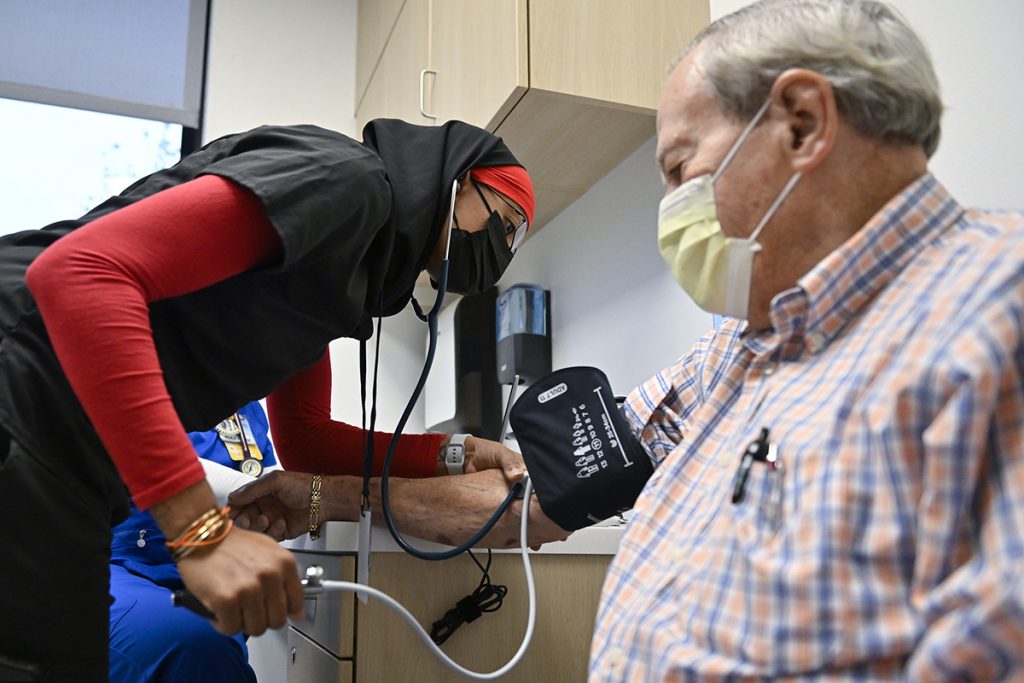
Medical assistant Tiara Lane takes the blood pressure of J. Harold Engle at Penn State Health Lancaster Medical Center. Engle was the first patient in the outpatient services building on opening day, Monday Oct. 3, 2022.
Burke goes through the standard check-in questions, verifying name, date of birth, allergies and medications while Lane wraps a blood pressure cuff around his right arm. Burke takes his pulse, goes through his surgical history and discusses any changes to his health.
When the medical assistants step out, Engle takes a breath and gazes around the room.
“Look at the market,” he says to his wife, pointing out a print of an original oil painting of Lancaster’s Central Market by local artist Lee Lovett.
Engle’s relationship with Penn State Health in Hershey goes way back. Three of his four children were born in the old Hershey Hospital, and he’s retired from selling office equipment, including typewriters, adding machines and cash registers to local businesses, such as the Milton S. Hershey Medical Center.
Dr. Joy Cotton knocks on the door and after entering, thanks him for being their first patient and reviews Engle’s health history.
He has a pacemaker and wants to make sure his doctors know the machine they use for his remote device checks might be unplugged for a few days during their move. “That should be fine,” Cotton assures him. “Your next check isn’t until November, and they’ll contact you if they can’t read it.”
At 9:20 a.m. the couple walk out the doors with a Penn State Health T-shirt and travel mug to take home with them as a memento of their first-day visit to the new medical center.
9:30 a.m.
It’s easy to see that Barb Armstrong has found her calling.
“Welcome! Come on in! I’m big, bad Barb the greeter,” she calls to a man walking into Penn State Health Lancaster Medical Center’s main lobby shortly after it opened on Monday morning.
“What’s your name and how can I help you?” she asks as he approaches her desk.
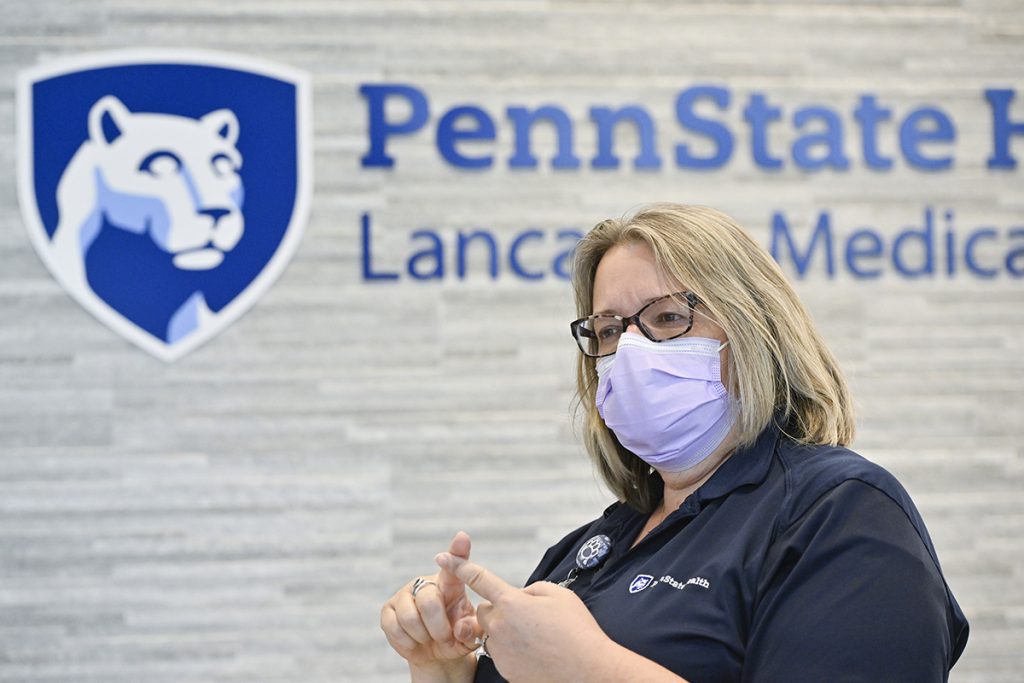
Main patient greeter Barb Armstrong gives directions to a guest in the main lobby at the Penn State Health Lancaster Medical Center Monday Oct. 3, 2022.
For those who enter the new hospital through the main entrance between 6 a.m. and 2:30 p.m. weekdays, Armstrong is the first person they meet. It’s a role she takes seriously.
“I represent Penn State Health Lancaster Medical Center,” she said. “I want the first face they see to be a friendly face.”
A knowledgeable one as well, which is why she has made it a priority to walk every nook and cranny of the hospital since she started in this role on July 8. In her life, she’s been a hospital patient and the loved one of a patient, so she understands the fear and anxiety that comes with both roles.
“I have empathy,” she said. “And so I hope I come across as a funny, kind person who tries to make it a better experience for people while they’re with us.”
Armstrong began her career with Penn State Health in 2018 at Lime Spring Outpatient Center, where she greeted visitors there. More than a year ago, while Lancaster Medical Center was still nothing more than a construction zone, hospital president Joe Frank and chief operating officer Claire Mooney recruited her to the new hospital as the lead greeter. It was an opportunity she couldn’t pass up.
When asked what she enjoys most about the new hospital, she answers quickly.
“The culture,” she says. “It’s very positive, very professional. We’re all part of the same team, all in it together, and I feel like everyone here is the best of the best in their roles.”
“Barb is amazing. She steps up and does whatever needs to be done, often without asking,” said her supervisor, Meghan Nigon, manager of Patient, Family and Community Relations. “Barb IS the Penn State Health experience.”
11:20 a.m.
Meghan Nigon, manager of Patient, Family and Community Relations at Penn State Health Lancaster Medical Center, is spending the morning welcoming visitors to the new hospital. Only a few patients have come through thus far, and she’s directed them to the outpatient building for their scheduled appointments. But she’s had “a lot” of community members pop in to say hello.
“They’re excited to see our new Medical Center,” she says. “While we can’t offer them a tour now that we’re open, we’re able to direct them to the cafeteria for breakfast or a cup of cocoa.” The reviews of the hospital and its cafeteria, she says, have been good.
Nigon comes to Penn State Health from a hospital in York. A resident of Lancaster County, she says she eagerly watched the construction of Lancaster Medical Center. She was excited to join the health system and stresses that the patient culture at Lancaster Medical Center is unique.
“We’re focused on relationship-based care,” she says. “We realize that we can’t take great care of patients without also caring for ourselves and colleagues.”
While there are no inpatients yet at the Medical Center, Nigon and her team are ready to address their needs and make them feel comfortable and welcome. And they have a bunch of get-well cards on hand, filled out by community members.
“At a Barnstormers game this summer, we invited people to fill out the cards,” Nigon says. It’s just another way that the community and the hospital have come together to support their neighbors.

Community members created get-well cards to be given to patients at Penn State Health Lancaster Medical Center starting on the first day, Monday, Oct. 3, 2022.
11:20 a.m.
Sean Woodard, a registered nurse in the Post-Anesthesia Care Unit, sits at a computer on the fourth floor. All around him, computer monitors show blank screens, awaiting data from the unit’s first patient.
“All of it is state-of-the-art,” he says.
Post-anesthesia is a critical care unit that serves as a stop between the operating room and recovery, where clinicians bring surgical patients out of anesthesia.
Noon
Coordination and communication are key to the successful opening of a hospital – and also to the daily operations.
On Lancaster Medical Center’s opening day, leaders from departments across Penn State Health and Lancaster Medical Center met at noon in the hospital’s command center for one of several daily recurring huddles.
The team worked their way through a spreadsheet of questions and concerns that had been reported and were being addressed, ranging from staff not being able to access some of their technology, to equipment that required vendor servicing, to vehicles that needed to be moved from the emergency department parking lot.
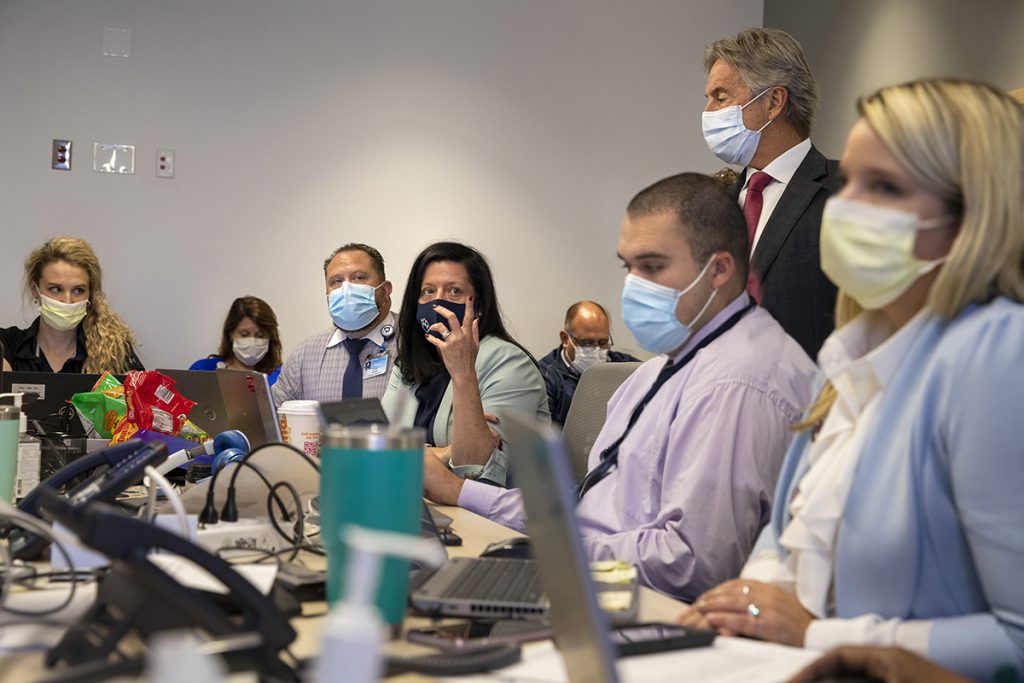
Claire Mooney, center, senior vice president and chief operating officer at Penn State Health Lancaster Medical Center, leads a meeting during opening day on Monday, Oct. 3, 2022.
Members of every department had the opportunity to provide a report or ask questions. The most-awaited report was that of the emergency department. As of noon, 13 patients were being treated in the emergency department; one was being admitted. The team was doing well, and staff throughout the hospital were in place and supporting the needs of these patients as planned.
All in all, the first five hours have gone very well, says Chief Operating Officer Claire Mooney.
12:20 p.m.
Bob Byrnes, a member of food services company Sodexo’s regional support staff, slides a pepperoni pizza into the brick pizza oven that gapes like an inverted smile from the wall of the Medical Center’s café.
Byrnes worked in the Tree House Café at Hershey Medical Center. He’s been spinning pizzas and other grub at Lancaster Medical Center since July. “I love it,” he said. “Everything is brand new.”
If you want pizza at Lancaster Medical Center, you’ve got options. People like Bob will custom-make a pie for you. Gluten-free? No problem. They have cauliflower crusts.
Employees, contractors and visitors fill the tables before the giant windows that look out on the full parking lot and gray day. Among them is Cara Grinestaff, who picks up a black and blue salad – romaine lettuce, blackened chicken, blue cheese, cucumbers and onions – and joins her colleague, Cari Krause, who brought her lunch from home.
Both are registered nurses in the endoscopy unit. Grinestaff has been working at the Medical Center since July 25, when her department was mostly empty rooms. She’s had an opportunity to get in on the ground floor and create a department from scratch.
She is most proud of WaveMark – the endoscopy unit’s cart system for storing, distributing and tracking supplies.
Krause has worked in the unit for a week and is already benefiting from the efforts of professionals like Grinestaff, who have created a great place to work. “She’s done an amazing job,” Krause says.
Jowo Weston, director of medical-surgical nursing, has opted for chicken cacciatore, pasta and steamed zucchini. She’s been manning phones with other leaders in the command center ― halfway through a 12-hour shift. She slept well last night, but she spoke with a colleague who never slept a wink.
“It’s like Christmas morning,” the colleague says.
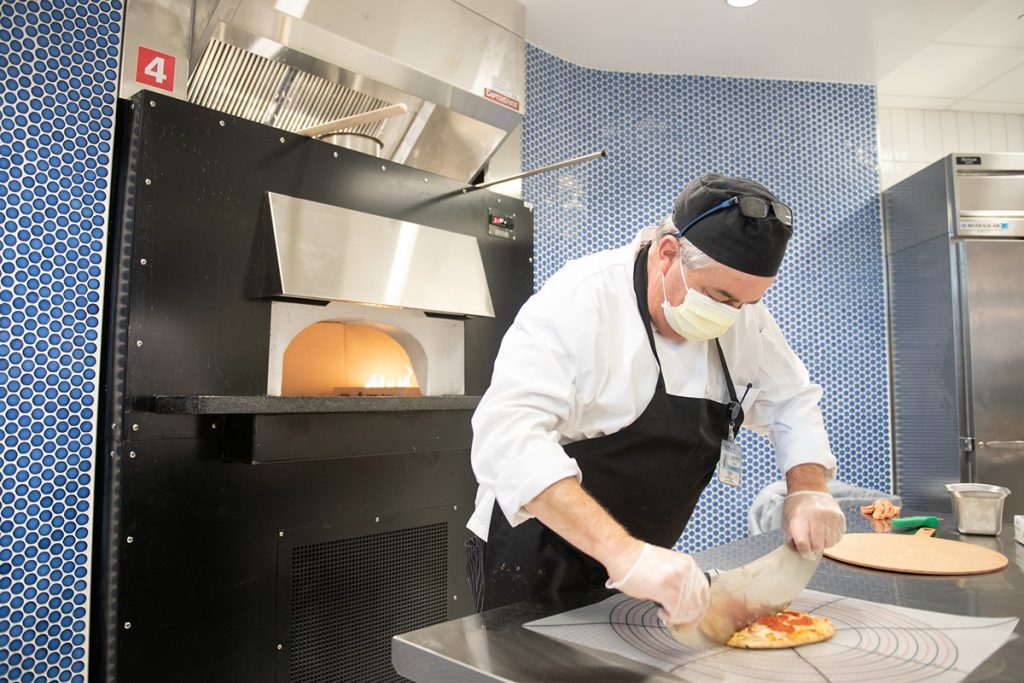
Bob Byrnes, Sodexo regional support staff member, cuts a pizza in the cafe at Penn State Health Lancaster Medical Center on Monday, Oct. 3, 2022.
1:15 p.m.
The staff in the third-floor intensive care unit expected their first patient early in the afternoon, but the situation changed, and the patient went to another floor of the hospital.
Had that been the patient’s destination, the health care team would have swarmed. An entire floor dedicated all at once to one patient. “It would have been the best care,” one of them yells.
Even minus the patients, Susan McDonald has had little spare time. The intensive care unit (ICU) nurse educator and her team take an inventory and work to fill gaps, making sure cabinets are filled with intravenous tubes, cup lids and utensils.
McDonald has worked as an ICU nurse for 30 years. She’s been a nurse educator for six years.
How do you educate nurses in a facility you’re building from the ground up?
“It’s a huge challenge,” she says, “but it’s less of a challenge than it would be if we didn’t have great leadership and staff.”
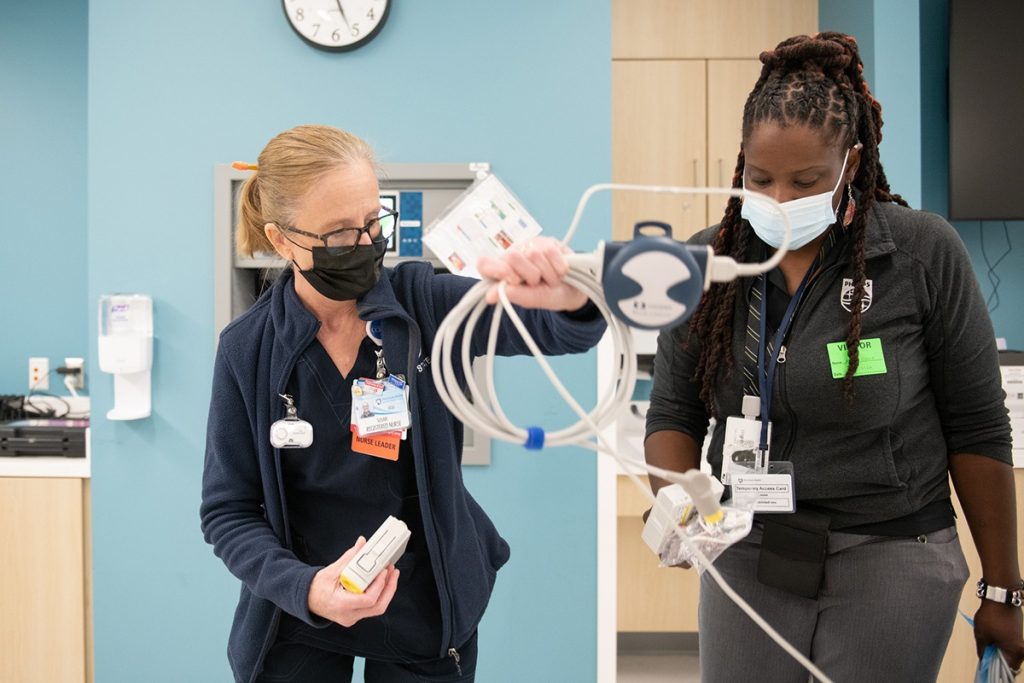
Susan McDonald, left, ICU nurse educator, works with Adina Reno from Phillips to set up cardiac monitors in the ICU before patients arrive on Monday, Oct. 3, 2022.
1:20 p.m.
If you ask Tina Mellinger to name one of the best features of the diagnostic imaging department in the new Medical Center, she’ll tell you it’s the windows.
Most hospital radiology departments are on the ground floor, aka, in the basement. At the new Medical Center, her department is located on the second floor.
“We’re used to being in the dungeon where you don’t see daylight from the time you get to work until the time you leave,” says Mellinger, chief technologist, radiology. “Here, I can just step out the door and see sunlight and a great view.”
She suspects the lucky placement came about because her department works so closely with the emergency department, also on the second level.
Convenience and atmosphere aside, Mellinger is excited to show off and start using the department’s Multitom Rax room, one of only 35 such rooms in the country.
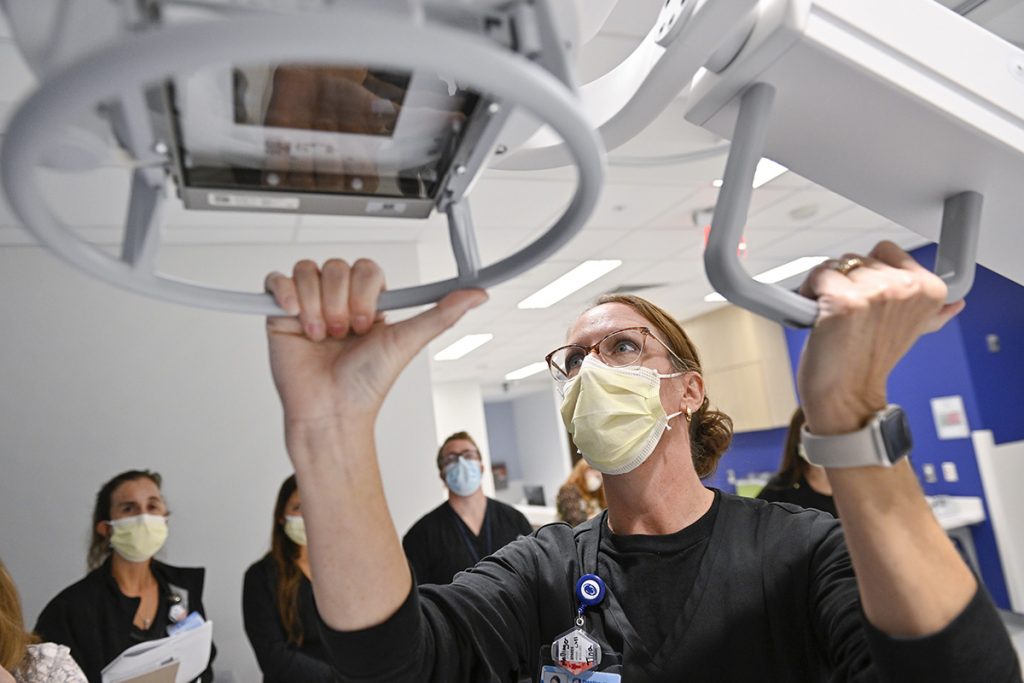
Chief of diagnostic image technology Tina Mellinger operates the Elara Max portable X-ray machine during a training at Penn State Health Lancaster Medical Center Monday Oct. 3, 2022.
“It’s pretty exciting to have this kind of equipment for people in this community,” she says. “We’re connected to all their Penn State Health specialists and can provide the same quality of care they’re used to, but at a closer and more convenient location.”
Inside the Multitom Rax room, a thin, gray diving board-like plank that can hold up to 560 pounds is the center of attention, but robotic arms and machines can tuck themselves out of the way in a corner or swivel around a patient at the press of a button.
“Especially for trauma, it’s nice because of the way the equipment moves,” says Katy Hurley, one of three Siemens medical equipment trainers who are on-site for three weeks to train staff and help them get comfortable using the new equipment. “We can move it around the patient instead of having the patient move.”
Across the hall, Lori Gillette, clinical applications specialist for Siemens, trains radiology techs on the finer points of navigating the Elara Max portable mobile X-ray machine. She points out handles, controls and charging features and shares some troubleshooting tips.
“We can push this into a patient’s room, and images pop up while they are assessing, so they see things on the spot,” she says. Mellinger adds, “There’s no delay in patient care, which is the most important thing.”
2 p.m.
Antonia Gonzalez was ready for a bad day.
Her 5-year-old son, Rashawn Collazo, was having another asthma attack. He’d been having them since he was just a baby – the first when he was just 1 year old. Trips to the emergency room have become par for the course, and today, during a well-child visit near her home in Columbia, the doctor told her it was time for another anxious ride in an ambulance.
She has three kids, including the little boy who has worried her nerves to the breaking point. “My head is spinning,” she says.
The ambulance driver asked if she wanted to take the child to the new Lancaster Medical Center. It had just started accepting patients a few hours earlier. Gonzalez agreed.
A little over an hour later, she doesn’t regret the decision. Rashawn lies in a hospital bed in the Emergency Department. A mask covers his face, delivering medicine to help him breathe.
“No waiting,” she says. “They work very quickly.”
A doctor told her they will likely admit Rashawn and administer albuterol until his breathing is under control again.
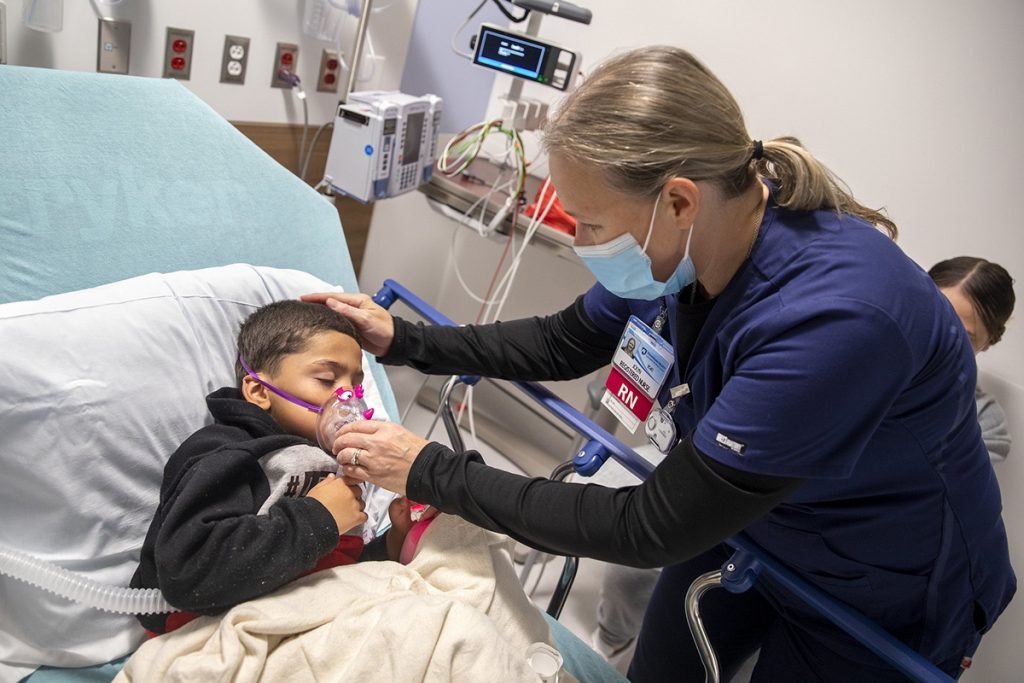
Joylyn Meadows, a registered nurse, helps 5-year-old Rashawn Collazo with his oxygen mask in the Emergency Department of Penn State Health Lancaster Medical Center on Monday, Oct. 3, 2022.
2:34 p.m.
Since opening at 7 a.m., the “tube”— a specimen delivery system that connects the Emergency Department (ED) with the first-floor laboratory at the new Penn State Health Lancaster Medical Center — has sent 13 vials of blood for complete blood count testing.
“Our phlebotomists will do their own blood draws in the inpatient rooms, but this tube system allows our ED team to get them to the lab quickly,” says Jim Book, medical laboratory scientist lead. “The level of blood tests has been manageable today. We really didn’t know what to expect. We’d heard that they were waiting for the new hospital to open.”
One sample was a rush because the patient was headed to the operating room. A few other samples have come from the outpatient building.
Under a hood protecting workers from potentially infectious materials, Book sets three tubes that have come from the Emergency Department — two respiratory panels and one a test specifically for COVID.
Book started at Lancaster Medical Center just one week ago and says he’s excited about the “newness” of the hospital. He says that many people might shy away from working on the very first day — let others address any potential glitches — but he was eager to start right away.
Colleague Janice Hibshman, a medical laboratory scientist, was among the first to arrive, clocking in well before 6 a.m. She’s run some of the complete blood count tests and a few coagulation tests. All the equipment—spread out over four rows with computer stations interspersed—is brand new. Hibshman, who has 38 years of laboratory experience and lives nearby, is most excited about the new and sophisticated instrumentation that comes with opening a new hospital lab.
The lab has duplicates of its many testing machines so they’ll always have a backup, Book says.
While Book and Hibshman run tests on the various complete blood count and hematology analyzers, other staff are organizing the blood bank in the many tall refrigerators at the back of the lab. Sherrie Van Den Eeden, a medical lab scientist, spent the morning logging in all of the blood products and is now setting up the platelets. While new to Penn State Health, she’s a proud Penn State alumna and a Lancaster resident.
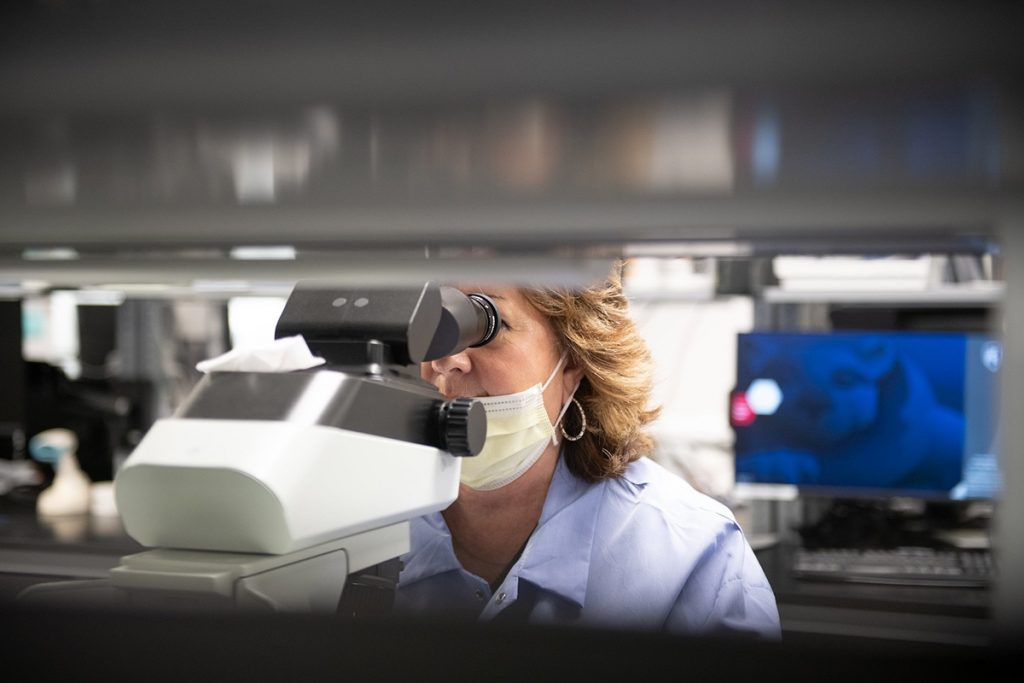
Medical lab scientist Janice Hibshman looks at slides in the lab at Penn State Health Lancaster Medical Center. The lab ran about 20 tests by noon.
3:30 p.m.
By midafternoon, the emergency department has treated 24 patients. Nine were brought in by ambulance.
Patients range in age from 3 years old to 90. They had minor lacerations and shoulders injuries. Some had bad chest pains and confusion.
“It’s been a good start for us,” said Dr. Chris DeFlitch, chief medical information officer at Penn State Health. “We realize a visit to the hospital isn’t typically a good day for most, but it is really a privilege for our teams from across Penn State Health to have the opportunity to help our new family at Lancaster Medical Center.” DeFlitch is one of a team of Penn State Health employees from other locations who are helping the Lancaster Medical Center team during its opening weeks.
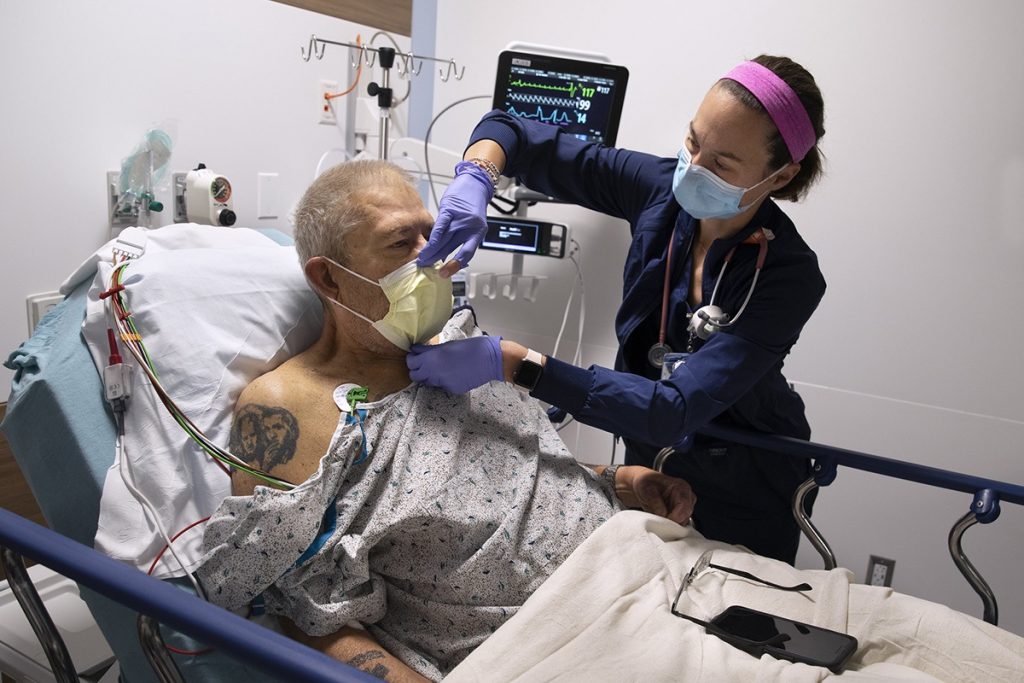
Brittney Patterson, a registered nurse, adjusts the mask of Daniel Rutledge during his visit to the Emergency Department at Penn State Health Lancaster Medical Center on Monday Oct. 3, 2022.
3:45 p.m.
Esteban Monserrat is dressed for success.
As Sodexo’s senior supervisor for Environmental Health Services at Penn State Health Lancaster Medical Center, Monserrat’s crisp shirt, pressed pants and on-brand tie reflect his approach to the job – focused and determined.
“I’m excited to help this community,” he said. “Some people think Environmental Health Services isn’t an important department, but it is. We help prevent the spread of infection and disease.”
Monserrat has been working toward this day for months, teaching staff how to clean and set up rooms and learning everything about the hospital.
“I want people to know we care and do our best,” Monserrat said. “We treat every patient like they’re a member of our own family.”
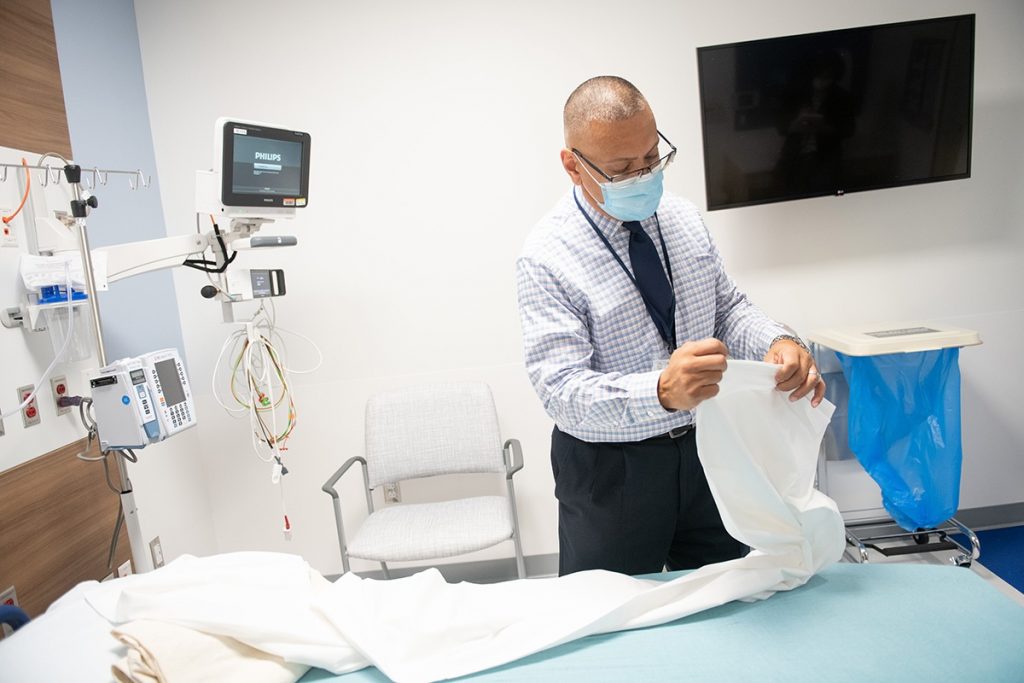
Esteban Monserrat, Sodexo senior supervisor for environmental health services, cleans and sets up a room in the Emergency Department at Penn State Health Lancaster Medical Center on Monday, Oct. 3, 2022.
5:45 p.m.
As the light outside the windows leans toward evening, Joe Frank, regional president of Penn State Health, strolls with two colleagues on the second floor.
He arrived before dawn and has been to every corner of the hospital, watching the army of health care professionals he and his team have worked for so many weeks and months to assemble on their biggest day so far.
“The day went largely as we planned,” he says. “It was very orderly. It was very calm. Everyone was enthusiastic.”
The number of patients coming into the emergency department was particularly heartening, demonstrating the hospital is meeting a community need. “The emergency department is going to be a real strength of this hospital,” he says.
He glances out at the waning light. “It feels good,” he says.
If you're having trouble accessing this content, or would like it in another format, please email Penn State Health Marketing & Communications.
